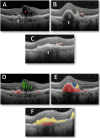Imaging biomarkers and artificial intelligence for diagnosis, prediction, and therapy of macular fibrosis in age-related macular degeneration: Narrative review and future directions
- PMID: 40059223
- PMCID: PMC12373684
- DOI: 10.1007/s00417-025-06790-0
Imaging biomarkers and artificial intelligence for diagnosis, prediction, and therapy of macular fibrosis in age-related macular degeneration: Narrative review and future directions
Abstract
Macular fibrosis is an end-stage complication of neovascular Age-related Macular Degeneration (nAMD) with a complex and multifactorial pathophysiology that can lead to significant visual impairment. Despite the success of anti-vascular endothelium growth factors (anti-VEGF) over the last decade that revolutionised the management and visual prognosis of nAMD, macular fibrosis develops in a significant proportion of patients and, along with macular atrophy (MA), is a main driver of long-term vision deterioration. There remains an unmet need to better understand macular fibrosis and develop anti-fibrotic therapies. The use of imaging biomarkers in combination with novel Artificial Intelligence (AI) algorithms holds significant potential for improving the accuracy of diagnosis, disease monitoring, and therapeutic discovery for macular fibrosis. In this review, we aim to provide a comprehensive overview of the current state of knowledge regarding the various imaging modalities and biomarkers for macular fibrosis alongside outlining potential avenues for AI applications. We discuss manifestations of macular fibrosis and its precursors with diagnostic and prognostic significance on various imaging modalities, including Optical Coherence Tomography (OCT), Colour Fundus Photography (CFP), Fluorescein Angiography (FA), OCT-Angiography (OCTA) and collate data from prospective and retrospective research on known biomarkers. The predominant role of OCT for biomarker identification is highlighted. The review coincides with a resurgence of intense research interest in academia and industry for therapeutic discovery and clinical testing of anti-fibrotic molecules.
Keywords: Age-related Macular Degeneration; Anti-Vascular Endothelium Growth Factors; Artificial Intelligence; Biomarkers; Colour Fundus Photography; Fluorescein Angiography; Macular Fibrosis; Optical Coherence Tomography.
© 2025. The Author(s).
Conflict of interest statement
Declarations. Informed consent: Not applicable. Conflict of interest: Nikolas Pontikos is the non-salaried co-founder and director of Phenopolis Ltd. Ismail Moghul has equity in READ AI Konstantinos Balaskas has equity in READ AI received speaker fees from Novartis, Bayer, Alimera, Allergan, Roche, and Heidelberg; meeting or travel fees from Novartis, Bayer and Boehringer-Ingelheim; compensation for being on an advisory board from Novartis, Bayer and Apellis; consulting fees from Novartis, Roche and Google; and research support from Apellis, Novartis, and Bayer. All other authors declare no relevant conflicts of interest. Research involving human participants and/or animals: This article does not contain any studies with humans or animals performed by any of the authors.
Figures



References
-
- Flaxman SR et al (2017) Global causes of blindness and distance vision impairment 1990–2020: a systematic review and meta-analysis. Lancet Glob Health 5(12):e1221–e1234 - PubMed
-
- Wong WL et al (2014) Global prevalence of age-related macular degeneration and disease burden projection for 2020 and 2040: a systematic review and meta-analysis. Lancet Glob Health 2(2):e106–e116 - PubMed
-
- Rosenfeld PJ et al (2006) Ranibizumab for neovascular age-related macular degeneration. N Engl J Med 355(14):1419–1431 - PubMed
-
- Rakic JLA, Brié H, Denhaerynck K, Pacheco C, Vancayzeele S, Hermans C, MacDonald K, Abraham I (2013) Real-world variability in ranibizumab treatment and associated clinical, quality of life, and safety outcomes over 24 months in patients with neovascular age-related macular degeneration: the HELIOS study. Clin Ophthalmol 7:1849–1858 - PMC - PubMed
-
- Brown DM et al (2009) Ranibizumab versus verteporfin photodynamic therapy for neovascular age-related macular degeneration: Two-year results of the ANCHOR study. Ophthalmology 116(1):57-65.e5 - PubMed
Publication types
MeSH terms
Substances
LinkOut - more resources
Full Text Sources
Miscellaneous

